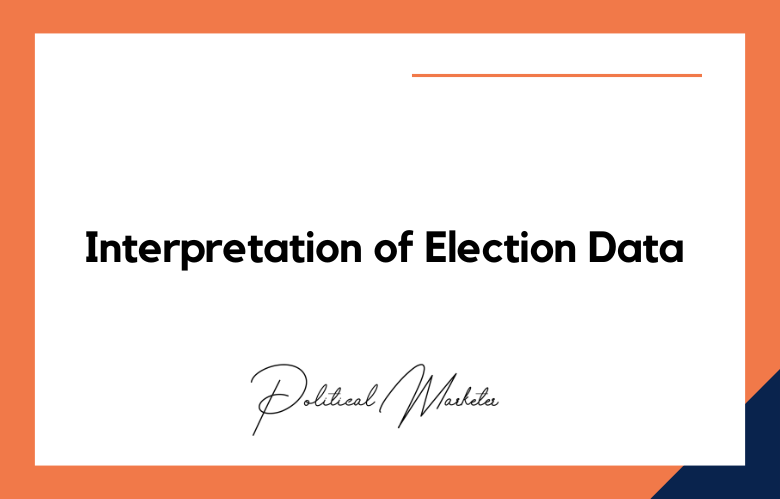Political campaigns today operate in an environment where data flows from numerous sources, including voter rolls, social media, surveys, turnout reports, and ground-level canvassing. Yet, possessing large volumes of data is not enough. The real value lies in interpretation: understanding what those numbers mean in the context of voter behavior, regional dynamics, and evolving political narratives. Campaigns that rely solely on surface-level figures often miss the deeper signals hidden beneath.
The shift from intuition-driven politics to data-driven campaigns has been one of the most significant transformations in modern elections. Traditionally, political leaders have relied on instinct, anecdotal feedback, and the advice of close aides to inform their strategies. While this approach occasionally worked, it left campaigns vulnerable to bias and blind spots. In contrast, contemporary political campaigns are now powered by analytics teams, dashboards, and predictive models that provide a far more reliable foundation for decision-making.
However, raw numbers without context can be dangerously misleading. For instance, a high turnout in a constituency may appear promising, but without breaking down who turned out — whether loyal supporters or opposition voters — the figure remains incomplete. Similarly, survey results that show broad approval for a candidate may overlook demographic nuances, such as age, caste, or urban-rural divides. Misinterpreting such signals can lead to flawed messaging, misallocation of resources, or overconfidence in areas where the ground reality is far less favorable.
Examples of misreading election data are readily available. Campaigns often celebrate favorable opinion poll percentages without questioning sample size or regional representation, only to face shock on election day. Others ignore micro-level trends such as a surge of first-time voters or shifts in issue-based sentiment, which can dramatically alter results. These mistakes highlight the critical lesson: numbers alone do not win elections; understanding them does.
Beyond Raw Numbers: The Importance of Interpretation
Raw election data provides only a partial picture of the political landscape. Without proper interpretation, figures such as turnout rates, approval percentages, or survey results can be misleading. Actual campaign value emerges when these numbers are placed in context—examining who voted, why they voted, and how different segments of the electorate responded. Practical interpretation transforms static data into actionable insights, enabling campaigns to refine their messaging, target the right voter groups, and anticipate shifts in public sentiment. In short, numbers inform, but interpretation empowers more brilliant campaign moves.
Difference Between Descriptive Statistics and Actionable Insights
Descriptive statistics summarize election data, such as overall voter turnout or average approval ratings. While useful as a snapshot, these figures often lack the depth required for strategic decisions. Actionable insights, on the other hand, explain what the numbers mean and how campaigns should respond. For example, instead of only noting that turnout increased by 8 percent, an actionable interpretation identifies which demographic groups drove that increase and whether they supported the campaign or the opposition.
Voter Behavior Requires Contextual Reading
Voter behavior does not follow a predictable or linear pattern. A rise in turnout in one region could signal strong support, while in another it could indicate mobilization by rivals. Similarly, identical survey percentages can represent different realities depending on demographic or geographic contexts. Practical interpretation identifies these hidden patterns, such as shifts among first-time voters, regional issue preferences, or changes in sentiment across age groups.
Risks of Misinterpreting Polls and Social Listening
Polls and social media analysis are valuable tools, but they can mislead if taken at face value. Small sample sizes, unrepresentative demographics, or poorly designed survey questions often distort results. Social listening data may overrepresent vocal groups while missing silent but significant voter segments. Misreading these signals can lead to campaigns misallocating resources, overestimating support, or overlooking emerging voter concerns. Proper interpretation requires validating findings with multiple data sources and on-the-ground intelligence.
Building a Data Interpretation Framework
Interpreting election data effectively requires a structured framework. Campaigns must begin with accurate data collection from reliable sources such as voter rolls, surveys, and digital engagement records. The next step is to clean the data, removing outdated or duplicate entries and ensuring consistency. Once refined, data should be segmented across geography, demographics, and voter behavior to reveal patterns that raw totals cannot show. This structured approach transforms scattered information into clear insights that guide targeting, messaging, and resource allocation, ensuring campaigns make more brilliant strategic moves.
Data Collection
Strong election data interpretation begins with reliable collection methods. Campaigns must gather information from diverse sources, including voter files, census records, opinion surveys, and digital engagement data such as social media activity. Ground-level inputs from canvassing and field reports add valuable context. The quality of insights depends directly on the accuracy and credibility of these sources, making disciplined collection the foundation for every subsequent stage of analysis.
Reliable Sources
Accurate interpretation starts with trustworthy data sources. Campaigns should draw from voter files, which provide demographic and registration details, census records that reveal population-level trends, and surveys that capture issue preferences and voter sentiment. Digital footprints, including search activity, online engagement, and social media behavior, add another dimension by highlighting real-time concerns and interests. Each of these sources contributes unique insights, and their combined use creates a stronger foundation for electoral analysis.
Balancing Traditional and Digital Inputs
While digital engagement offers speed and volume, traditional canvassing remains essential for ground truth. Door-to-door interactions, community meetings, and field observations capture nuances that digital metrics often miss, such as hyper-local issues or interpersonal voter concerns.
Data Cleaning
Election data is only as strong as its accuracy. Cleaning ensures that errors, duplicates, and outdated records do not distort insights. This process involves standardizing voter details, verifying survey responses, and removing incomplete or inconsistent entries. By refining the dataset, campaigns improve reliability and reduce the risk of basing strategies on flawed information. Clean data forms the backbone of precise interpretation and strengthens every stage of analysis that follows.
Removing Duplicate, Outdated, or Irrelevant Entries
Election databases often contain errors that can mislead analysis if left unchecked. Duplicate entries may inflate the number of registered voters or distort turnout projections. Outdated records, such as those of voters who have moved or passed away, can create false assumptions about support levels in specific constituencies. Irrelevant data, including incomplete survey responses or unverified digital profiles, adds noise without offering meaningful insights. Removing these inaccuracies ensures the dataset reflects the most reliable picture of the electorate.
Handling Missing or Inconsistent Responses
Incomplete or inconsistent data is another major challenge in election analysis. Missing demographic details, such as age or constituency, can weaken segmentation efforts. Conflicting entries, like mismatched addresses or multiple survey answers from the same voter, reduce credibility. Addressing these issues involves applying standardized formats, cross-verifying entries with official records, and flagging unreliable responses. By correcting gaps and inconsistencies, campaigns create a cleaner dataset that supports accurate voter modeling and precise campaign strategies.
Data Segmentation
Segmentation transforms large voter datasets into meaningful groups that reveal patterns hidden in raw totals. Campaigns can break down data by geography, such as constituencies or polling stations, to identify regional strengths and weaknesses. Demographic segmentation highlights variations across age, gender, education, or community groups, while behavioral and issue-based segmentation shows how voter concerns and loyalties shift over time. By organizing data into these categories, campaigns can target messages more precisely, allocate resources effectively, and design strategies that resonate with distinct voter groups.
Geographic Segmentation
Breaking down voter data into geographic units, such as constituencies, wards, and polling booths, enables campaigns to identify areas of firm support and pinpoint where intervention is needed. This level of detail enables the design of booth-level strategies, the efficient deployment of volunteers, and the allocation of resources based on local priorities and needs. Geographic segmentation also reveals regional differences in turnout and issue salience that broader data often masks.
Demographic Segmentation
Demographics remain one of the most reliable predictors of voter behavior. Segmenting by age, gender, education, or caste and community (particularly relevant in India) highlights how distinct groups respond to campaign messages. For example, younger voters may prioritize employment and education, while older voters may focus more on healthcare and retirement planning, such as pensions. By identifying these variations, campaigns can craft messages that resonate with the concerns of each demographic group rather than relying on generic appeals.
Psychographic and Behavioral Segmentation
Beyond location and demographics, understanding the mindset and behavior of voters is critical. Psychographic segmentation categorizes voters based on their values, motivations, and issue preferences. Behavioral segmentation tracks actual voting patterns, such as loyalty to a party, swing tendencies, or issue-based shifts. Identifying loyal supporters helps campaigns maintain their core base, while recognizing swing voters enables the development of targeted persuasion strategies. Tracking issue-based voters ensures campaigns adapt their messaging to emerging concerns that influence electoral outcomes.
Turning Data into Insights
Once collected, cleaned, and segmented, election data must be transformed into actionable insights. Visualization tools, such as heat maps, dashboards, and trend charts, help campaigns identify regional strengths, track shifts in voter sentiment, and monitor turnout projections. Predictive models further sharpen interpretation by forecasting turnout, identifying swing groups, and mapping issue-based concerns. Integrating offline inputs from canvassing with online engagement metrics provides a comprehensive view of the campaign. This translation of raw numbers into clear insights enables campaigns to adjust messaging, reallocate resources, and respond quickly to emerging voter behavior.
Visualization Techniques
Visualization turns complex election data into clear and actionable insights. Heat maps highlight regional variations in support, helping campaigns identify strongholds and weak areas. Dashboards enable real-time tracking of turnout, voter sentiment, and campaign activity, allowing managers to adjust strategies quickly. Trend charts reveal shifts in public opinion over time, showing whether messages are resonating or need refinement. By presenting data visually, campaigns move beyond raw figures to patterns that inform more intelligent decisions.
Heat Maps for Regional Analysis
Heat maps transform raw voting data into visual patterns that highlight geographic variations in support. They enable campaign teams to identify areas where a party has strong support and where performance is lagging. By mapping turnout rates, vote shares, or issue preferences at the constituency or polling booth level, campaigns can identify priority areas for outreach and resource deployment. This spatial perspective ensures strategies address local realities instead of relying only on statewide or national averages.
Dashboards for Campaign Managers
Dashboards provide campaign managers with real-time access to key performance indicators, including turnout projections, volunteer activity, and fundraising progress. A well-structured dashboard consolidates data from multiple sources, presenting it in a clear and accessible format for informed decision-making. For example, if volunteer engagement drops in a target constituency, managers can act immediately by redirecting resources or intensifying field activity. Dashboards not only monitor progress but also enable rapid adjustments that strengthen campaign efficiency.
Trend Lines for Sentiment Shifts
Tracking sentiment over time is critical for understanding how voters respond to campaign messaging and political events. Trend lines drawn from surveys, social media monitoring, or public opinion trackers reveal whether approval is rising, falling, or holding steady. Campaigns can use these insights to refine communication, adjust narrative framing, or counter adverse developments before they gain traction. By observing shifts in sentiment across different voter groups, campaigns ensure that strategies remain aligned with the electorate’s evolving priorities.
Predictive Models
Predictive models use historical data and current voter information to forecast electoral outcomes. These models can project turnout levels, identify which groups are most likely to shift preferences, and estimate the impact of specific campaign issues. By applying statistical techniques and machine learning, campaigns can simulate different scenarios, such as how a policy announcement might influence undecided voters. Predictive models transform past and present data into forward-looking insights, helping campaigns anticipate challenges and plan more effective strategies.
Voter Turnout Forecasting Models
Turnout forecasting models utilize past voting patterns, demographic data, and real-time inputs to estimate the number of voters likely to participate in an upcoming election. These models can highlight areas where turnout is expected to rise or fall, enabling campaigns to adjust their ground operations accordingly. For example, if projections suggest low turnout among younger voters, campaigns can prioritize targeted outreach and mobilization efforts to close the gap. Accurate turnout forecasts help campaigns allocate resources effectively and avoid overestimating support.
Issue Salience Models
Voter concerns often shift over time, and issue salience models measure which topics dominate public attention. By analyzing survey data, social media discussions, and news coverage, these models identify the issues most likely to influence voting behavior. Jobs, education, healthcare, and water supply are typical examples where salience varies by region and demographic. Campaigns that monitor issue salience can adapt messaging to address emerging priorities, ensuring their platform resonates with undecided or swing voters.
Churn Models: Identifying Likely Voter Drop-Offs
Not all supporters remain loyal. Churn models track patterns that indicate when voters may disengage or switch allegiances. These models analyze past behavior, issue-based dissatisfaction, and shifts in sentiment to flag groups at risk of leaving the campaign’s base. Identifying these potential drop-offs early allows campaigns to re-engage with targeted communication, address concerns, and reinforce commitment. Preventing churn is often as critical as winning over new voters, especially in closely contested constituencies.
Integrating Offline and Online Data
Election analysis becomes stronger when campaigns combine traditional field inputs with digital engagement data. Offline sources such as door-to-door canvassing, booth-level turnout reports, and community meetings capture ground realities that raw numbers alone cannot explain. Online sources, including social media sentiment, search trends, and digital ad performance, reveal real-time shifts in voter interest. When integrated, these datasets provide a comprehensive view of voter behavior, enabling campaigns to validate digital insights with field intelligence and adjust strategies with greater accuracy.
Door-to-Door Canvassing Reports and Digital Ad Performance
Field reports from canvassing offer direct insights into voter concerns at the booth and neighborhood level. When campaigns compare this information with digital ad performance data, they can determine whether the issues raised in person align with the themes driving online engagement. For example, suppose canvassing reveals strong concern about local water shortages, but digital ads on employment generate higher click-through rates. In that case, campaigns can adjust messaging to address both priorities without overemphasizing one channel. This integration ensures outreach reflects both lived experiences and online behavior.
Social Media Sentiment and Ground Intelligence
Social media provides fast feedback on voter sentiment, but it often reflects the voices of the most vocal groups rather than the full electorate. Ground intelligence from volunteers, local leaders, and community meetings validates or challenges these digital signals. For instance, an online spike in support for a particular issue may appear significant, but field feedback may show that it resonates only within specific demographics or regions. Combining the two prevents campaigns from overestimating digital enthusiasm and ensures strategies remain grounded in actual voter priorities.
Common Mistakes in Election Data Interpretation
Campaigns often misinterpret election data by relying too heavily on surface-level numbers or incomplete datasets. Overconfidence in national surveys for local races, ignoring the margin of error, and overlooking undecided voters can lead to distorted strategic planning. Another frequent error is treating all constituencies as uniform, failing to account for regional and demographic differences. Social media data can also mislead if campaigns mistake online enthusiasm for broad-based support. Recognizing and avoiding these mistakes allows campaigns to base decisions on accurate insights rather than misleading signals.
Overreliance on National Surveys for Local Races
National or statewide surveys often capture broad trends but fail to reflect constituency-level dynamics. Relying solely on these figures can cause campaigns to overlook local issues or shifts in voter priorities. For example, a candidate may appear strong in statewide polls while actually trailing in key swing constituencies. Localized data provides the necessary detail for targeted strategies.
Misjudging Margin of Error and Sample Bias
A candidate polling at 48 percent in a study with a 3 percent margin of error may actually be ahead or behind. Similarly, biased samples that overrepresent specific demographics create a false sense of voter sentiment. Campaigns must evaluate methodology before treating survey numbers as accurate.
Ignoring Undecided Voters or Late Swing Behavior
Undecided voters and those who shift preferences close to election day often decide outcomes. Campaigns that focus only on current support levels miss the influence of this group. Ignoring undecided or late swing voters can lead to complacency in competitive races. Targeted outreach and continuous tracking help account for these critical shifts.
Treating All Constituencies as Homogeneous
Assuming uniform voter behavior across constituencies oversimplifies electoral dynamics. Urban, rural, and semi-urban areas often respond differently to messaging, and even neighboring constituencies can prioritize distinct issues. A one-size-fits-all approach wastes resources and dilutes the effectiveness of the campaign. Tailored strategies rooted in local realities produce stronger results.
Confusing Correlation with Causation
Campaigns sometimes mistake statistical correlation for cause-and-effect relationships. For instance, higher turnout in one region may coincide with increased support but not necessarily cause it. Treating correlation as causation can lead to misdirected strategies, such as assuming turnout spikes guarantee favorable outcomes. Careful analysis is required to distinguish genuine drivers of voter behavior from coincidental patterns.
Case Applications: Smarter Campaign Moves
Interpreting election data effectively allows campaigns to translate insights into practical actions. Turnout analysis can guide get-out-the-vote efforts, ensuring resources target areas where mobilization will have the highest impact. Budget reallocation based on voter trends helps balance spending between rural and urban constituencies, promoting a more equitable distribution of resources. Monitoring shifts in issue-based sentiment allows campaigns to adjust narratives, respond to voter concerns, and maintain relevance throughout the election cycle. These applications demonstrate how thoughtful interpretation converts raw data into strategic moves that improve campaign outcomes.
Interpreting Early Voting Data for GOTV Strategies
Early voting patterns provide a preview of turnout trends and voter enthusiasm. By analyzing these numbers, campaigns can identify areas where support appears strong and areas where participation is lagging. If data shows strong early voting among committed supporters, the campaign can shift its resources toward persuading undecided voters. Conversely, if turnout is weak in target constituencies, field teams can intensify their efforts through door-to-door canvassing, phone banking, and reminder campaigns. This responsive approach ensures Get Out The Vote (GOTV) strategies remain focused on boosting participation where it matters most.
Using Turnout Projections to Reallocate Budgets
Turnout projections help campaigns determine where to allocate their limited resources. If rural areas show signs of higher participation than expected, while urban areas lag, budget allocations can be adjusted to reinforce urban outreach. This may include increasing digital ad spending in metropolitan centers or deploying more volunteers to high-density constituencies. By linking projections with budget strategy, campaigns reduce wasteful expenditure and maximize the impact of each outreach effort.
Adjusting Narrative Based on Issue-Based Sentiment
Voter sentiment can shift quickly in response to emerging issues. A rise in concern about unemployment, water shortages, or public safety may require campaigns to adjust their core message. Data analysis of surveys, focus groups, and social media sentiment can detect these changes early. Campaigns that respond quickly by emphasizing relevant policies or highlighting achievements on those issues are more likely to maintain voter trust and prevent opponents from dominating the conversation.
Role of Political Data Analysis Services
Specialized political data analysis services help campaigns move from raw numbers to actionable strategies. These services utilize advanced tools, including GIS mapping, survey modeling, and AI-driven sentiment analysis, to provide deeper insights than in-house teams can often achieve. They validate data accuracy, highlight patterns that may go unnoticed, and recommend tactical adjustments to improve voter targeting, messaging, and resource use. By relying on professional analysis, campaigns reduce the risk of misinterpretation and gain a more straightforward path toward more innovative electoral strategies.
Why Campaigns Should Partner with Professional Analysts
Interpreting election data requires more than access to numbers. Professional analysts bring technical expertise, methodological rigor, and the ability to contextualize findings within the realities of politics. Campaign teams often lack the capacity to manage large datasets or spot subtle patterns in voter behavior. Partnering with experts ensures that interpretation is consistent, accurate, and actionable, reducing the risk of flawed strategies based on misread signals.
Tools and Platforms Used
Political data analysts rely on specialized tools that go beyond basic spreadsheets. Dashboards integrate multiple data streams, allowing for real-time tracking of campaign performance. Geographic Information System (GIS) mapping highlights regional variations in turnout, support, and issue salience down to the booth level. AI-driven survey analysis and sentiment tracking provide early warnings about shifts in public opinion. These tools not only process data but also convert it into visual and predictive insights that campaign managers can act on quickly.
Case Example: Correcting a Flawed Voter Outreach Plan
Consider a campaign that allocated resources to urban centers based on high levels of online engagement. Professional analysis revealed that while digital activity was intense in cities, actual voter turnout potential was higher in semi-urban areas. By correcting this misinterpretation, the campaign redirected volunteers and ad spending toward constituencies with greater growth potential. As a result, it improved ground contact rates and voter mobilization in critical swing regions. This example illustrates how expert interpretation prevents costly errors and strengthens overall campaign performance.
Strategic Recommendations for Campaign Teams
Campaigns must treat data interpretation as an ongoing process rather than a one-time exercise. Cross-checking analytical insights with field feedback helps validate accuracy and avoid missteps. Scenario planning allows teams to anticipate multiple outcomes, such as turnout surges or last-minute shifts in voter sentiment. Establishing rapid-response data cells ensures campaigns can adjust quickly during critical phases. Finally, transparent reporting of data findings within the team strengthens coordination and ensures that leadership decisions are based on reliable insights.
Cross-Check Interpretation with On-Ground Feedback
Data-driven insights must always be tested against field intelligence. Local canvassers, volunteers, and community leaders provide context that numbers alone cannot capture. For example, sentiment analysis may suggest growing support for a candidate, but field reports could reveal skepticism within specific neighborhoods. Verifying data with ground realities prevents campaigns from relying on misleading patterns and ensures strategies remain credible.
Use Scenario Planning
Election conditions can shift rapidly, so campaigns should prepare for a range of possibilities. Scenario planning enables teams to anticipate potential outcomes and design effective responses in advance. For instance, if turnout projections for younger voters continue to increase, the campaign can allocate more resources to digital outreach. If turnout trends stagnate, resources can be shifted toward mobilization efforts. Planning around “if-then” scenarios helps campaigns adapt quickly without waiting for problems to escalate.
Build Rapid-Response Data Cells
During the peak of a campaign, decisions often need to be made within a matter of hours. Establishing rapid-response data cells enables teams to process information, monitor shifts, and provide recommendations in real time. These cells act as quick decision hubs that combine analytics with field updates, ensuring the leadership team receives timely insights. This setup reduces delays and strengthens the campaign’s ability to counter unexpected developments.
Maintain Transparency in Data Reporting
Transparent data reporting within the campaign organization improves coordination and trust. When analysts clearly present assumptions, sources, and limitations, leadership can make informed choices. Transparency also prevents internal miscommunication, which could otherwise be distorted by selective reporting and lead to an incorrect strategic direction. A culture of open reporting ensures every decision is based on shared, verifiable insights rather than fragmented interpretations.
Conclusion
Election campaigns today are fueled by an abundance of data, but numbers alone do not determine outcomes. Data becomes meaningful only when campaigns interpret it with precision, connect it to voter behavior, and transform it into actionable strategies. Without careful interpretation, even the most comprehensive datasets can lead to false confidence or wasted resources.
The real competitive advantage lies in more profound insights. Campaigns that go beyond descriptive statistics and embrace contextual analysis understand not just what the numbers show, but why they matter. Interpreting turnout patterns, issue salience, and voter sentiment enables campaigns to anticipate challenges, respond quickly to shifts, and build strategies grounded in reality rather than assumptions.
This ability to convert raw information into strategy is what separates effective campaigns from those that track numbers. By investing in structured frameworks, predictive models, and professional analysis, political teams ensure that data interpretation guides every critical decision.
Campaigns that want to strengthen their approach should act now. Request a free consultation to explore tailored political data analysis services and learn how your team can transform raw numbers into more innovative and strategic campaign moves.
Election Data for Smarter Campaign Moves: FAQs
Why Is Interpreting Election Data More Important Than Just Collecting It?
Because raw numbers can be misleading when taken at face value, interpretation reveals context, voter behavior, and actionable strategies.
What Is the Difference Between Descriptive Statistics and Actionable Insights in Political Campaigns?
Descriptive statistics summarize voter data, while actionable insights explain patterns and guide campaign decisions.
How Can Misinterpreting Voter Turnout Data Affect Campaign Strategy?
Turnout spikes may seem positive, but could include opposition voters. Misreading them can lead to misplaced confidence or wasted resources.
Why Should Campaigns Focus on Both Offline and Online Data Sources?
Offline sources, such as canvassing, capture local realities, while online sources, like social media, track real-time sentiment. Together, they give a complete picture.
What Are the Key Steps in Building a Data Interpretation Framework?
Data collection, data cleaning, and segmentation form the foundation for accurate election analysis.
Which Sources Are Most Reliable for Election Data Collection?
Voter files, census data, surveys, and digital engagement records provide the strongest baseline for analysis.
Why Is Data Cleaning Critical Before Interpretation?
Errors, duplicates, and outdated entries distort results. Cleaning ensures accuracy and credibility.
How Can Campaigns Handle Missing or Inconsistent Voter Data?
By standardizing entries, cross-verifying with official records, and removing unreliable responses.
What Is Voter Segmentation and Why Does It Matter?
Segmentation divides voters by geography, demographics, and behavior, allowing campaigns to tailor outreach.
How Does Geographic Segmentation Help Campaigns?
It highlights strongholds and weak areas at the booth or constituency level, guiding targeted resource allocation.
What Role Does Demographic Segmentation Play in Elections?
It identifies distinct concerns of groups such as youth, women, or specific communities, helping campaigns craft precise messages.
What Is Psychographic or Behavioral Segmentation?
It categorizes voters by values, issues, or loyalty, revealing swing voters, loyalists, and issue-driven groups.
How Do Visualization Techniques Improve Election Data Interpretation?
Heat maps, dashboards, and trend lines simplify complex data, making insights easier to act upon.
What Are Predictive Models in Election Analysis?
They forecast turnout, track issue salience, and identify voter churn, enabling them to implement proactive strategies.
Why Do Campaigns Often Misinterpret Election Data?
Common mistakes include overreliance on national surveys, ignoring margins of error, overlooking undecided voters, and confusing correlation with causation.
How Can Turnout Projections Improve Campaign Resource Allocation?
They show where participation is likely to rise or fall, guiding budget adjustments between rural and urban areas.
How Can Campaigns Adjust Strategy Based on Changing Voter Sentiment?
By tracking issue-based shifts and updating messaging to address evolving priorities such as jobs, education, or local concerns.
Why Should Campaigns Consider Professional Political Data Analysis Services?
Experts provide advanced tools, validate accuracy, and prevent costly misinterpretations that campaigns may miss in-house.
What Tools Do Professional Analysts Use in Political Campaigns?
Dashboards, GIS mapping, AI-driven survey analysis, and sentiment tracking systems.
What Are the Key Recommendations for Campaign Teams When Interpreting Data?
Cross-check with field feedback, utilize scenario planning, establish rapid-response data cells, and ensure transparent reporting.











